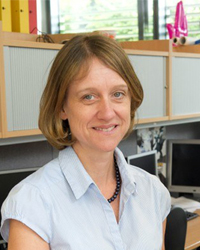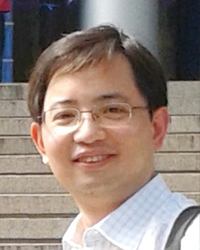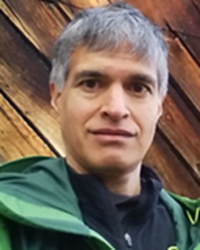Graph‐based Methods for Learning and Inference Problems in Pattern Analysis
Antonio Robles-Kelly and Francisco Escolano
Monday, August 20, 2018, 14:00-17:00, 307A, 3rd Floor
Tutorial Abstract
This tutorial provides a detailed study of graph-based methods in pattern recognition. The course aims at covering the fundamental principles of stochastic, spectral, probabilistic and manifold based methods related with graphs and their applications to segmentation and grouping, matching, classification and recognition. The tutorial will also cover recent trends and developments related to deep networks and link inference in the structural pattern analysis space.
Tutorial Outline
The following topics will be covered:
Ø Fundamentals of graph theory
· Historical evolution of graph-based methods in pattern recognition
· Advantages and drawbacks of Graph-based methods.
Ø Graphs and stochastic processes
· Probabilistic graphical models, Bayesian networks and Markov random fields Learning in graphical models (EM algorithm, Newton-like methods)
· Inference in graphical models (Junction Tree algorithm, variational inference, Monte Carlo inference)
· M-best inference and M-best graph matching.
· Applications in Computer Vision and Image Processing
Ø Graph-spectral methods
· The spectrum of a graph
· Relation of the spectrum to Markov chains
· The random walker and semi-supervised learning. Image segmentation.
· Graph kernels and random walks
· Graph-spectral methods for segmentation and grouping
· Graph-spectral methods for graph matching
Ø Information theory for graphs
· Entropy/complexity of a graph.
· Information-theoretic kernels between graphs.
· Mutual information between graphs.
· Bregman divergences between graphs
Ø Graphs and manifolds
· The Laplacian of the graph and the Laplace-Beltrami operator in Riemannian manifolds
· The incidence mapping and its relation to the Riemannian metric
· Relationship between graphs and the Schrödinger, wave and heat kernels
· Ranking with the graph Laplacian. Preserving the harmonic structure.
· Stiefel and Grassmannian Manifolds. Applications to image sets and sequences
· Graph densification and sparsification.
Ø Deep networks and link inference
· Link inference, Knapsack problems and Bayesian inference
· Bayesian deep learning
· Deep nets for feature and graph representation learning
Ø Fundamentals of graph theory
· Historical evolution of graph-based methods in pattern recognition
· Advantages and drawbacks of Graph-based methods.
Ø Graphs and stochastic processes
· Probabilistic graphical models, Bayesian networks and Markov random fields Learning in graphical models (EM algorithm, Newton-like methods)
· Inference in graphical models (Junction Tree algorithm, variational inference, Monte Carlo inference)
· M-best inference and M-best graph matching.
· Applications in Computer Vision and Image Processing
Ø Graph-spectral methods
· The spectrum of a graph
· Relation of the spectrum to Markov chains
· The random walker and semi-supervised learning. Image segmentation.
· Graph kernels and random walks
· Graph-spectral methods for segmentation and grouping
· Graph-spectral methods for graph matching
Ø Information theory for graphs
· Entropy/complexity of a graph.
· Information-theoretic kernels between graphs.
· Mutual information between graphs.
· Bregman divergences between graphs
Ø Graphs and manifolds
· The Laplacian of the graph and the Laplace-Beltrami operator in Riemannian manifolds
· The incidence mapping and its relation to the Riemannian metric
· Relationship between graphs and the Schrödinger, wave and heat kernels
· Ranking with the graph Laplacian. Preserving the harmonic structure.
· Stiefel and Grassmannian Manifolds. Applications to image sets and sequences
· Graph densification and sparsification.
Ø Deep networks and link inference
· Link inference, Knapsack problems and Bayesian inference
· Bayesian deep learning
· Deep nets for feature and graph representation learning
Speaker Introduction
 Antonio Robles-Kelly received a B.Eng. degree in Electronics and Telecommunications from the Inst. Tecnológico y de Estudios Superiores de Monterrey (ITESM), Mexico, and a PhD Computer Science from the University of York, UK, in 2003. While pursuing his PhD at York, in 2001, he received the Gibbs/Plessey Award to the best research proposal to visit an overseas research lab. In 2003, he completed his PhD and remained in York until Dec. 2004 as a Research Associate under the MathFit-EPSRC framework. In 2005 he moved to Australia and took a research scientist appointment with National ICT Australia (NICTA) at the Canberra Laboratory. Together with this appointment, he became an adjunct academic at the Australian National University (ANU). From 2007 to 2009, he was a Postdoctoral Research Fellow of the Australian Research Council. In 2016, he became a Principal Researcher of the CSIRO with the Cyber Physical Research Programme at Data61. He has served as the president of the Australian Pattern Recognition Society (APRS) and is an associate editor of the Pattern Recognition Journal, the IET Computer Vision Journal and a Senior Member of the IEEE. He is also the president of the TC2 (Technical Committee on structural and syntactical pattern recognition) of the International Association for Pattern Recognition (IAPR) and Adjunct Associate Professor at the ANU. He has been a technical committee member, area and general chair of several mainstream computer vision and pattern recognition conferences.
Antonio Robles-Kelly received a B.Eng. degree in Electronics and Telecommunications from the Inst. Tecnológico y de Estudios Superiores de Monterrey (ITESM), Mexico, and a PhD Computer Science from the University of York, UK, in 2003. While pursuing his PhD at York, in 2001, he received the Gibbs/Plessey Award to the best research proposal to visit an overseas research lab. In 2003, he completed his PhD and remained in York until Dec. 2004 as a Research Associate under the MathFit-EPSRC framework. In 2005 he moved to Australia and took a research scientist appointment with National ICT Australia (NICTA) at the Canberra Laboratory. Together with this appointment, he became an adjunct academic at the Australian National University (ANU). From 2007 to 2009, he was a Postdoctoral Research Fellow of the Australian Research Council. In 2016, he became a Principal Researcher of the CSIRO with the Cyber Physical Research Programme at Data61. He has served as the president of the Australian Pattern Recognition Society (APRS) and is an associate editor of the Pattern Recognition Journal, the IET Computer Vision Journal and a Senior Member of the IEEE. He is also the president of the TC2 (Technical Committee on structural and syntactical pattern recognition) of the International Association for Pattern Recognition (IAPR) and Adjunct Associate Professor at the ANU. He has been a technical committee member, area and general chair of several mainstream computer vision and pattern recognition conferences. Francisco Escolano received his Bachelor degree in Computer Science from the Polytechnical University of Valencia (Spain) in 1992 and his PhD degree in Computer Science from the University of Alicante in 1997. Since 1998, he has been an Associate Professor with the Department of Computer Science and Artificial Intelligence of the University of Alicante. He has been post-doctoral fellow with Dr. Norberto M. Grzywacz at the Biomedical Engineering Department of the University of South California in Los Angeles, and he has also collaborated with Dr. Alan L. Yuille at the Smith-Kettlewell Eye Research Institute of San Francisco. Recently, he visited the Liisa Holm's Bioinformatics Lab at the University of Helsinki. His research interests are focused on the development of efficient and reliable computer vision algorithms for biomedical applications (tracking of intravascular sequences), active vision and robotics (mid-level geometric structures obtained through junction grouping, stereo and appearance based methods for the localization of mobile robots, SLAM), and video-based surveillance (motion detection and object tracking). All these developments have been inspired by information theory. Actually, he is the author of the unique CVPR book on the subject: Information Theory in Computer Vision and Pattern Recognition. Springer, Computer Imaging, Vision, Pattern Recognition and Graphics, New York, 2009. More recently, he has been collaborating with other researchers, such as Edwin R. Hancock, to extend information theory to graphs: graph complexity, information-theoretic dissimilarities between graphs, reversible embeddings, etc. He is Vice-president of the TC2 (Technical Committee on structural and syntactical pattern recognition) of the International Association for Pattern Recognition (IAPR). He has been a technical committee member, area and general chair of several mainstream computer vision and pattern recognition conferences.
Francisco Escolano received his Bachelor degree in Computer Science from the Polytechnical University of Valencia (Spain) in 1992 and his PhD degree in Computer Science from the University of Alicante in 1997. Since 1998, he has been an Associate Professor with the Department of Computer Science and Artificial Intelligence of the University of Alicante. He has been post-doctoral fellow with Dr. Norberto M. Grzywacz at the Biomedical Engineering Department of the University of South California in Los Angeles, and he has also collaborated with Dr. Alan L. Yuille at the Smith-Kettlewell Eye Research Institute of San Francisco. Recently, he visited the Liisa Holm's Bioinformatics Lab at the University of Helsinki. His research interests are focused on the development of efficient and reliable computer vision algorithms for biomedical applications (tracking of intravascular sequences), active vision and robotics (mid-level geometric structures obtained through junction grouping, stereo and appearance based methods for the localization of mobile robots, SLAM), and video-based surveillance (motion detection and object tracking). All these developments have been inspired by information theory. Actually, he is the author of the unique CVPR book on the subject: Information Theory in Computer Vision and Pattern Recognition. Springer, Computer Imaging, Vision, Pattern Recognition and Graphics, New York, 2009. More recently, he has been collaborating with other researchers, such as Edwin R. Hancock, to extend information theory to graphs: graph complexity, information-theoretic dissimilarities between graphs, reversible embeddings, etc. He is Vice-president of the TC2 (Technical Committee on structural and syntactical pattern recognition) of the International Association for Pattern Recognition (IAPR). He has been a technical committee member, area and general chair of several mainstream computer vision and pattern recognition conferences. 




